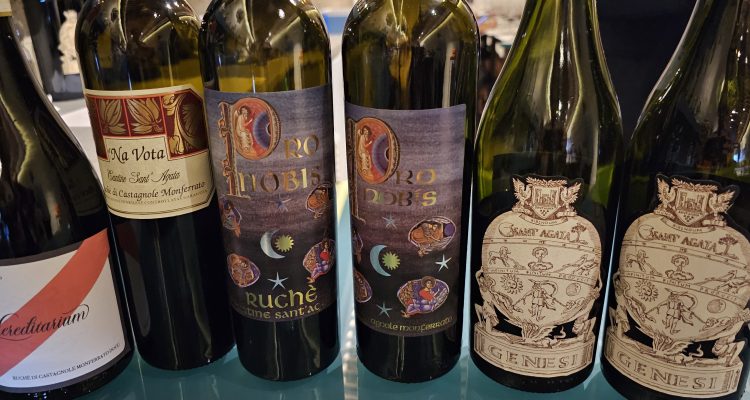Discovering a native wine or local cuisine is a delicious outcome of travel. Recently I visited the Monferrato region of Piedmont. Though Barbera and spumante are famous there, this trip was focused on Ruché in the country village of Scurzolengo, a 15-minute drive northeast of Asti. At Cantine Sant’Agata I sipped my first glass of Ruché, an intriguing, indigenous red wine.
The tasting room and winery overlook the Monferrato hills and, in the distance, the Monte Rosa massif of the Pennine Alps.
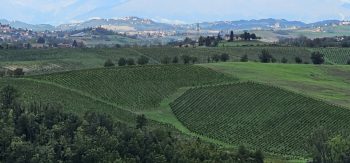
At dinner that evening, Sant’Agata owner Cavallero welcomed visitors as if they were long lost friends. As he introduced the wines, it was obvious the vintner is a person who dives deeply into his interests. Ruché, relatively unknown outside Monferrato, became his passion 30 years ago.
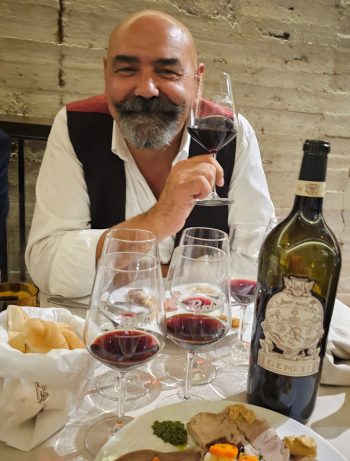
The revival of Ruché
Cavallero helped resurrect the medium bodied, aromatic, and spicy Ruché grape from oblivion. In the U.S., Ruché is most often served at wine-centric Italian restaurants. Several sommeliers and restauranteurs share their experience in selling this unique Piedmontese wine.
Why did Cavallero become besotted with Ruché? When Cavallero joined Cantine Sant’Agata which his father founded in 1968, the winery sold wines locally in demijohns. Small amounts of sweet Ruché were produced for special occasions. Cavallero began to explore the rare, two rows of Ruché grapes the local priest nurtured to make dry wine.
Meanwhile, the mayor of the larger village in the area, Castagnole Monferrato, encouraged residents to plant Ruché and make it dry like the priest’s wine. After accepting the challenge, Cavallero experimented with growing Ruché in their clay and calcareous holdings and encouraged his father to plant more Ruché. These vineyards are within the UNESCO World Heritage Site of the Monferrato vineyard landscapes.
In the early 1990s when Cavallero and his winemaker brother Claudio took over the winery, they refocused the business on high quality, bottled wines. Ruché is the winery’s top selling wine. Cavallero was the first vintner to export Ruché to the U.S. in 1997, and the U.S. is their largest export market. With Cavallero’s support, Ruché di Castagnole Monferrato received DOCG status, the highest designation from the regional Consorzio in 2010.
I spent a day exploring Turin before visiting Sant’Agata, a 75-minute drive away. During lunch at Sofrino Ristorante on Piazza San Carlo, I learned the sommelier recommended Sant’Agata ‘Na Vota Ruché to pair with pasta or meat but not fish. On a warm day with a Piedmontese favorite, tarajin egg pasta, I chose a white wine, deferring a full Ruché experience to my winery visit later that day.
With the lineup of wines at the Sant’Agata, bar, I knew Ruché starred on the dinner menu.
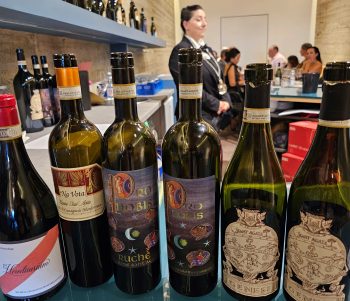
It’s a family business: Tenimenti Famiglia Cavallero
Before dinner, Cavallero spoke about his Hereditarium project. To further honor the local heritage of Ruché and his family’s commitment to elevate it, Cavallero selects the wine for Hereditarium only in outstanding vintages from the best barrels. The wine also honors his brother Claudio, an artist and musician in addition to winemaker, who died in 2022. Cavallero donates half of the Hereditarium profits to support artists.
Manifesting his expansive view of hospitality and gastronomy, Cavallero then led us to his wine cellar where his Ruché, Barolo, Barbera d’Ast Superiore and more wines rest in barrels. Here we tasted the spirits he has produced since the mid-90s including gin, rum, vermouth and an amaro called Bitternaza. His daughters are active in the business, named Tenimentiligia Famiglia Cavallero, which translates to the agrarian holdings of the family Cavallero.
We noshed on tapas prepared by his daughter Altea and her staff from Il Cicchetto, the Asti wine bar and restaurant Cavallero founded in 2012. The name means “the shot” which refers to the over 100 gins including Cavalerro’s on the restaurant’s shelves and other liquors. Cavallero sells five gins and dedicates four hectares to 34 types of botanicals as flavoring agents.

Dining at Cantine Sant’Agata
“’Na Vota is our easiest Ruché to drink,” said Cavallero as dinner began. “In the Piedmontese dialect, the label means ‘once upon a time’ or ‘a challenge.’ This was the first dry Ruché we produced in 1990.” I liked the wine’s mix of tannin and spice.
As soon as I lifted the glass, I noted the floral aromatics in the Il Cavaliere Ruché paried with veal tonnato and Russian salad. The creamy salad and sauce for the veal paired well with the spicy wine showing a red fruit profile.
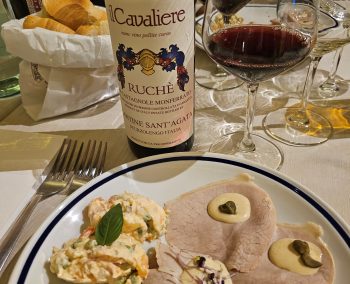
Full-bodied with higher alcohol due to the drying of grapes after harvest, Genesi Ruché was served with bollito misto (mixed boiled meats). The not-overly-sweet Genesi also paired well with dessert—two versions of bonet, a Piedmontese soft pudding made with chocolate or hazelnut. Genesi is the bestselling Sant’Agata wine in the U.S.
As an adjunct to the flow of Ruché, Cavallero offered his refreshing Gin Agricole and Tonic as an after dinner digestive.
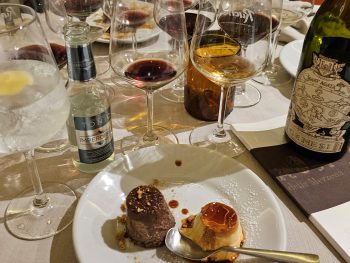
The next day, we dined on lunch prepared by the cooks from Il Cicchetto. The main course of beef cheeks was paired with Pro Nobis Ruché. Cavallero called this wine his “cru” and offered a nod to the Ruché producing priest with its name meaning (I pray) “for us.” This long-aged wine offers a smooth mouthfeel with some lively tannins.
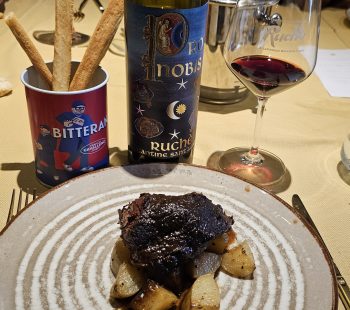
Though our meals at Sant’Agata were full-on gourmet, I made a mental note to try one of Cavallero’s Ruchés chilled for warm weather, al fresco dining.
After a morning seminar on vermouth production, the dessert of crèma al mascarpone (think inside layer of tiramisu) was paired with a special cookie named caritin di Scurzolengo and Caravello’s vermouth.
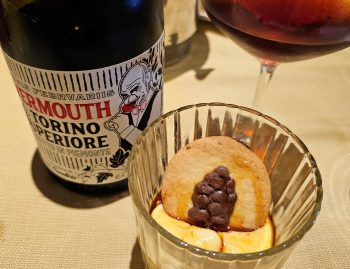
Perspective on Ruché at three U.S. restaurants
Matteo Sarica is a Silicon Valley IT professional and an avid wine consultant. While developing the wine lists for Italico Wine Bar and Restaurant and Terún Pizzeria and Restaurant, both in Palo Alto, Sarica met Cavallero during a distributor’s visit to the restaurants. “Ruché with its good tannins, nice berry fruit and spiciness pairs well with food that has juicy succulence. Try a glass of Cavallero’s Ruché with a ribeye or red pizza,” said Sarica.
Sarica highlighted the quality consistency of Sant’Agata Ruché vintage to vintage, and added, “We need more people, especially sommeliers, to turn the spotlight on Ruché.”
At A16 in San Francisco, Wine Director and co-owner Shelley Lindgren also emphasized that Ruché is a pleasure to sell. “I find that most people who have tasted it, find it aromatic and fun to pair with food.”
Though the name A16 refers to a famous highway in Southern Italy and the restaurant menu leans to the South, Lindgren lists many Italian wines. Lindgren has always liked Ruché and feels that interest in the wine has not waned. For guests who find Barolos and Barbarescos too bold, Lindgren may suggest Ruché. “I position Ruché in the category of aromatic reds. This includes Lacrima di Morro d’Alba, Rosesse di Dolceacqua, Cesanese Olevano and Aleatico. Some wine-savvy guests request Ruché at A16 because it is not broadly available.”
Her top recommendations for pairing Ruché include ricotta gnocchi with sweet English peas and parmesan brood or salumi and salsiccia pizza with broccolini. Lindgren added that pricing from $58 to $68 compares favorably to other wines.
During my visit to Sant’Agata. I met Kama Geary who was traveling in the area. Geary is the co-owner of Bacaro in the Lower East Side of Manhattan. Named for the workingmen’s pubs in Venice that serve cicchetti, Geary specializes in an array of Italian small plates and entrées with a wine list that targets Northern Italy.
Geary was also pleased with the diversity and excellent craftmanship of the Ruchés we tasted in Scurzolengo. After several distributors introduced her to Ruché a decade ago, she began listing Ruché at Bacaro.
“We help people discover Ruché. It is a pretty wine with aromatics of flowers. The wine is not overly tannic and shows bright, fresh fruit,” said Geary.
As for pairings with Ruché, Geary began with starters, either stacciatella, the creamy insides of burrata (mozzarella curds and cream) with figs, honey, hazelnuts and rosemary or gnocchi con fungi with mixed mushrooms, asparagus, and peas. The top pairing, added Geary, is the entrée of garlic shrimp over creamy polenta. Creaminess, she said, and the textural elements of spicy shrimp and hazelnuts, stand up well with the fruity, spicy wine.
The pricing of Ruché from $72 to $100 is comparable, she said, to the more familiar Barbera which she serves also by the glass because guests recognize it.
After tasting Cavallero’s gin at Sant’Agata, she purchased the spirit for her bar. When guests order Negronis, she may tell them about the origin of the Piedmontese gin.
Eager to share her perspective on Cavallero, Geary said. “Franco has such a big, happy personality. Along with his daughters, they have such passionate and fun natures. He represents the Piedmontese countryside, the producer without airs who loves to make wine and spirits.”
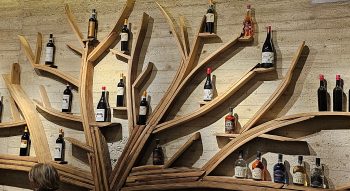
Story and photos by Deborah Grossman

